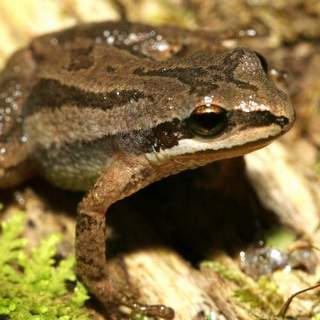Western Chorus Frog
Overview:
Scientific Name: Pseudacris triseriata triseriata
Size: 0.7 – 1.5” (adult length)
Status: Can be common to abundant locally, but many populations have recently declined, particularly in suburban and agricultural areas.

Habitat:
Prefer marshes, meadows, swales, and other open habitats. Also may be found in wet woods or wooded swampy areas. Will largely be found under refuges such as logs, rocks, and leaf litter..
Adult Coloration:
Brown, reddish, or tan to gray or olive background color with a conspicuous white or cream stripe along upper lip, with a dark brown stripe bordering the top that runs from the nose through the eye and down to the groin. Usually three dark stripes down the back that may be broken into spots. Belly cream or white, occasionally with dark speckling on chest and throat.
Adult Characteristics:
Skin slightly rough though moist. Toes slightly expanded. Males a bit smaller than females with a yellowish vocal pouch apparent as a grayish flap of skin in the throat (most visible during breeding season). Voice: Short scratchy “cree-ee-ee-ee-eek” that rises in pitch. Similar to the sound of a pocket comb being strummed with a fingernail. e.g., http://www.youtube.com/watch?v=kwBuSFDXQlE
Larvae Characteristics:
Tadpoles rounded and gray or brown above, sometimes with golden mottling when older. Tail fins clear with dark speckling. Intestines visible through bronze belly. Maximum length is around 1.2”.
Species Confused With:
The Spring Peeper does not have a distinct white upper lip stripe and usually has an X-shaped mark on the back. Blanchard’s Cricket Frog has rougher skin and also does not have a white lip line or dark stripes on the back. Small Wood Frogs may be mistaken for Chorus Frogs due to similar markings on the lip, but these can be distinguished by their dorsolateral folds (raised ridges extending down each side of the back).
Distinction between subspecies:
Two subspecies of P. triseriata (sometimes referred to as the Striped Chorus Frog) occur in Michigan. Pseudacris t. maculata is known as the Boreal Chorus Frog and occurs in the western Great Lakes region. It is very similar to the Western Chorus Frog but has shorter hind legs (with a tendency to hop rather than leap) and usually has greener striping on the back which is often broken into rows of spots.
References:
- Amphibians and Reptiles of the Great Lakes Region by Jim Harding
